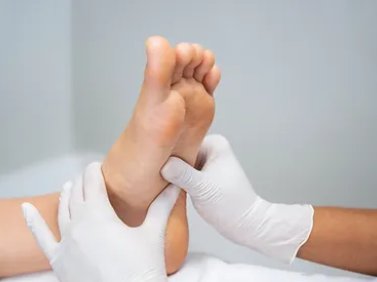Plantar Fasciopathy
Injury Guide

Plantar fasciopathy, commonly known as plantar fasciitis, is a prevalent foot condition that can significantly affect athletes and their performance. This guide aims to provide athletes with an understanding of the symptoms, causes, and rehabilitation strategies associated with plantar fasciopathy. By shedding light on this condition and offering solutions, we hope to encourage athletes to take their first steps toward recovery.
Symptoms:
Athletes experiencing plantar fasciopathy often encounter a variety of symptoms that can hinder their athletic pursuits. The most common symptom is intense heel pain, especially during the first steps after waking up or following prolonged periods of inactivity. This pain may also manifest during physical activities, leading to discomfort and reduced performance. The affected area may appear swollen and tender to the touch, with pain radiating along the arch of the foot.
Anatomy:
The plantar fascia is a thick band of fibrous tissue that spans the bottom surface of the foot, connecting the heel bone (calcaneus) to the base of the toes. It provides support to the arch of the foot and helps with shock absorption during weight-bearing activities.
In plantar fasciopathy, the plantar fascia undergoes repetitive stress and strain, resulting in microtears, inflammation, and degeneration. This condition often occurs when the fascia is subjected to excessive tension or repetitive trauma, causing it to become irritated and inflamed.
The implications of plantar fasciopathy are significant for athletes. As the plantar fascia becomes compromised, it loses its ability to absorb shock and provide proper support to the arch of the foot. This can lead to instability, altered foot mechanics, and increased stress on other structures, such as the bones, ligaments, and tendons of the foot and lower leg.
The pain experienced in plantar fasciopathy is primarily due to the inflammation and microtears in the plantar fascia. The pain is typically localized to the heel, where the fascia attaches to the heel bone, but it can also radiate along the arch of the foot. Athletes may notice that the pain is most intense during the initial steps after periods of rest or inactivity, as the fascia tightens during periods of non-use.
The implications of plantar fasciopathy extend beyond the physical discomfort. Athletes may experience limitations in their athletic performance, as the pain and dysfunction can affect their ability to walk, run, jump, or engage in their chosen sports. This can lead to frustration, decreased participation, and potential loss of competitive edge.
Understanding the anatomy of the plantar fascia and its implications on plantar fasciopathy allows athletes to appreciate the complexity of this condition. By seeking appropriate treatment and rehabilitation, athletes can address the underlying factors contributing to the disorder and regain optimal foot function, pain relief, and improved performance.
At our physical therapy clinic, we specialize in providing targeted interventions and therapies that address the anatomical considerations of plantar fasciopathy. Our comprehensive approach takes into account the specific needs of athletes, aiming to restore the integrity of the plantar fascia, improve foot mechanics, and promote healing and optimal performance.
By focusing on the anatomy of the foot and the implications of plantar fasciopathy, we empower athletes to take an active role in their recovery and make informed decisions about their treatment options.
Causes:
Plantar fasciopathy arises from overuse and strain on the plantar fascia, a thick band of tissue connecting the heel bone to the toes. Several factors contribute to the development of plantar fasciopathy among athletes. Firstly, repetitive impact from high-impact sports or activities such as running, jumping, or dancing places excessive stress on the plantar fascia, causing microtears and sometimes inflammation. Secondly, poor foot mechanics, including overpronation or high arches, can lead to imbalanced forces acting on the plantar fascia, resulting in strain and subsequent pain. Thirdly, improper footwear, such as ill-fitting shoes, exacerbate the condition by increasing stress on the plantar fascia. Finally, training errors, such as rapidly increasing training intensity, neglecting proper warm-up and cool-down routines, or engaging in excessive training without adequate rest periods, can overload the plantar fascia, leading to injury.
Rehab Strategies:
At Latitude Physiotherapy, we offer a tailored approach to treat plantar fasciopathy and aid athletes in their recovery. Our skilled physical therapists assess the athlete’s condition and develop a personalized treatment plan. They employ various techniques such as manual therapy, and stretching exercises to alleviate pain, reduce inflammation, and promote healing.
Footwear assessment is another crucial aspect of our rehabilitation strategy. We conduct a comprehensive analysis of an athlete’s footwear and provide recommendations for appropriate athletic shoes to encourage optimal biomechanics of the foot and ankle. In some cases, temporary orthotic devices may be prescribed to unload overused tissues of the foot.
Stretching and strengthening exercises play a significant role in the rehabilitation process. At Latitude Physiotherapy, we guide athletes through targeted stretching and strengthening exercises that focus on the calf muscles, Achilles tendon, and the plantar fascia itself. These exercises help improve flexibility, reduce tension, and promote healing. Additionally, strengthening exercises for the foot and lower leg muscles help improve stability and reduce strain on the affected area. Use code N34CANQK at medbridgego.com to learn how to do our favorite exercise for plantar fasciopathy.
Our clinic utilizes various modalities and techniques to enhance the rehabilitation process. These may include manual therapies such as gua sha, cupping, dry needling, soft tissue mobilization and joint manipulation all aimed at reducing pain, inflammation, and promoting tissue healing.
To prevent future recurrences and optimize performance, we offer comprehensive biomechanical evaluations. These evaluations identify any underlying issues contributing to plantar fasciopathy and allow us to address them effectively. By addressing these factors, we aim to provide long-term relief and enhance overall athletic performance.
Plantar fasciopathy can be a debilitating condition for athletes, but with the right treatment and rehabilitation, a full recovery is possible. At our physical therapy clinic, we specialize in providing tailored rehabilitation programs that address the root causes of plantar fasciopathy. By combining evidence-informed techniques, comprehensive assessments, and personalized care, we aim to help athletes regain their mobility, alleviate pain, and achieve their athletic goals. If you’re an athlete struggling with plantar fasciopathy, we encourage you to seek professional help at our clinic and take the first step towards a pain-free and active lifestyle.
Let’s
Work
Together
Ready to get started? Click here. General questions? Read our FAQ page. Have a specific question? Leave us a message!
